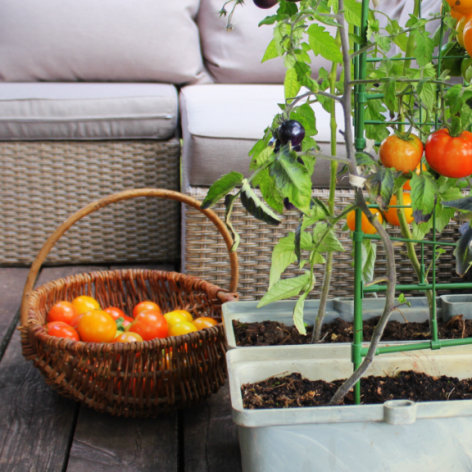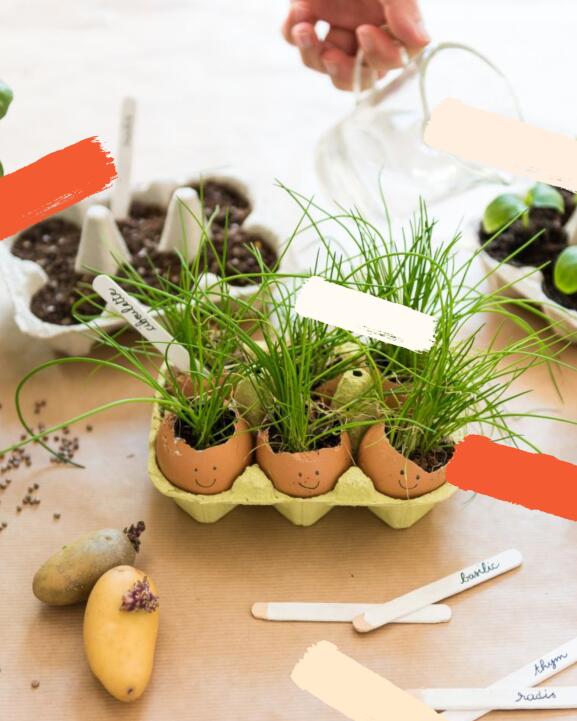
LET’S DO IT
A vegetable garden? What a great idea!
In the " I made it " category, few things are as satisfying as eating your own vegetables. Okay, maybe you'll have a great Christmas dinner, but first things first. Whether you've got green fingers or two left feet, a farm or a windowsill, the pleasure of watching vegetables grow is something everyone can have! But keep your greengrocer’s number just in case...

Materials
- A good compost
- Sunshine (for you AND your plants)
- Water (enough, but not too much, subtle)
- Soap (for you, not your plants!)
- A little patience (you don't have to push it, you can do it)
- A small gardening spade
- Pots, tubs, planters, etc.
- Protective bags, canvas, tarpaulins (enough to have fun without redoing your floor)

Instructions

Step 1: Surface area and location
We know you're bursting with ideas! But start small. The classic beginner's mistake is to think too big. If you have space, in a garden for example, limit yourself to an area of 6m2. On a balcony, depending on the space available, choose a longer planter to space out your plants. A 1m-long wooden kit should suffice. Make window sills your own, install hanging planters, and think about exposed indoor surfaces (kitchen worktops, desks, etc.).
Display! The sun will decide for you. Do the test on a normal day: the planned location should be able to benefit from six hours of sunlight. And be protected from the wind as much as possible, even if it means installing protective panels.

Step 2: It's all in the soil
It's where it all begins... and potentially ends! In the garden, there's no need to dig up absolutely everything: some simple weeding is all you need to prepare your corner. Above ground, whether in a pot, tub or window box, start with a drainage layer, with clay balls for example, then be generous with quality potting soil (adapted to your type of plant, it's better), and finish with a thin layer of compost or organic fertiliser.

Step 3: Choosing your first victims
Start with the foolproof options. There's no shame in starting off easy! There's nothing better than radishes to help you get the hang of it: you can sow them from March to August and they'll grow in just a few weeks, giving you the confidence boost you need! A class above: cherry tomatoes and salads. Easy to grow, especially if you buy them as seedlings, they have the advantage of growing quickly and continuing to produce regularly. For cherry tomatoes, use a pot at least 30cm in diameter, and opt for stocky plants rather than tall ones.
Don't forget about herbs either! They are virtually indestructible (that's not a challenge!), require no expertise and can even be bought as seeds. Basil, mint, chives, thyme, sage, parsley - just the thing to liven up your dishes and cocktail parties!
Step 4: The art of watering
Ah, watering... too much water? Not enough? Water too wet? One of mankind's great mysteries... As a general rule, it's better to under-water than over-water, especially if you're growing in a pot or window box and there are no holes in them to allow proper drainage. At the height of summer, three waterings a week for outdoor tomatoes, two for radishes and lettuces. And don't get the leaves wet, as this encourages the development of disease! Spraying only serves to dust them off.
As far as aromatic plants are concerned, they generally prefer dry but cool soil. If in doubt, stick your finger a few centimetres into the soil to gauge its degree of moisture and don't be fooled by a dry surface!
In any case, don't panic, don't give up and learn from your mistakes. Keep a record of your victories and defeats, and don't hesitate to ask a horticulturist near you for advice. It's by cooking that you become a cook... you get the idea!

The result
Now all you have to do is turn the pointer to find out how far the water has travelled and explain each of the 4 stages in your own words! Simple is best!

Tip:
Don't get dirt under your fingernails It's the ultimate gardening look, and one we could do without! Of course, there's always the option of gloves, but let's be honest, it's still fun to have your hands in the dirt! To limit dirt under your nails, rub the underside of your nails with a bar of soap before starting. The layer will prevent soil from becoming lodged and will wash off easily. No need to use lavender soap, it won't grow!

Other ideas
Permaculture
What is it? In simple terms, it's the association of cultures that help each other. For example, tomatoes and basil: the latter repels insects and enhances the flavour of the former. Don't try planting mozzarella though... Another power couple: borage and strawberries. This pretty lady keeps slugs away and strengthens strawberry plants.
Compost
It's the finishing touch to a successful floor, and your secret weapon on the path to zero waste. Recycle your organic waste to feed your plants: from peelings to coffee grounds, good compost is living soil from which your plants draw nutrients. There are a whole host of online resources for making your own compost, depending on the space available. Ask around, too, as more and more shared composters are being set up locally!
- Discover Blow drying and straightening: how to avoid the heat waves
Blow drying and straightening: how to avoid the heat waves
- Discover Cornflower, the little knapweed we love to see blooming
Cornflower, the little knapweed we love to see blooming
NEWSLETTER
Nature often has the solution...
All our tips for taking care of yourself, the natural way.






